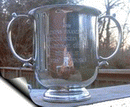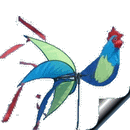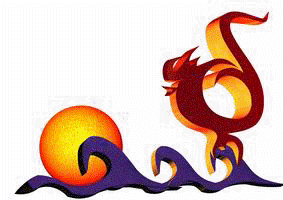
More details
- The J 105 155% genoa
- More J/105 155% genoa
- J105 masthead instruments
- J-105 Sparcraft mast
- The strong J/105 top of mast permits a masthead spinnaker for European J/105 class and IRC races
- J105 forehatch
![]()
Discussion on gybes
From: http://www.j105.org/~oldforum/discus/messages/5/227.html
| Kevin Horrigan
Posted on Saturday, August 26, 2000 - 5:15 pm: |
I am a new
j105 owner and have really enjoyed the boat. My problem is jibing with
the biggest chute. I don't seem to have the time to get the lazy sheet
pulled around the forestay and tend to get a wrap. Am I trimming the
main wrong? I've tried a slow turn and also fast. Any tips? Thanks |
| Daniel Heun - Chicago
Posted on Saturday, August 26, 2000 - 9:43 pm: |
Make sure
the sheet is outside the forestay, yet inside the spinnaker - this is
not an America'S Cup Jibe. The easiest way I have found is to have the trimmer standing in the pit area with both sheets in his two hands. Have the bowman ready to help pull the new sheet around and then you are ready to go. Take up on the slack on the new sheet. Make sure the tack line is no more that two feet off the sprit, that way you reduce the risk of wrapping the tack line around the pole during the jibe. Start turning the boat down wind, completely release, I mean all the off the winch the loaded spin sheet (make sure the sheet does not catch on anything), then have the bowman on the bow and the trimmer in the pit start pulling in the new sheet about as fast as possible, while the driver turns through the jibe and starts to head up to help fill the sail. The spinnaker should snap as it fills. Don't turn too fast, or you will cause a wrap. As the driver see the clew get around the forestay, then head up to fill the chute. Good luck. |
| Stuart Burnett - Richmond, VA - # 198 LEGACY
Posted on Saturday, August 26, 2000 - 10:13 pm: |
I find
that most jibing problems on LEGACY are helmsman-induced. When I don't
pay attention to the chute and just turn the boat, we tend to have
problems. Remember, every time you jibe the a-sail, you induce 1/2 of an
hour-glass in the sail as you invert it. Just a little in-attention and
the wind will do the rest. I find that light winds call for a slow turn to downwind, followed by an accelerating turn back to your reaching, speed-build, angle. The acceleration out of the turn seems to cause some heel and induce enough centrifugal force in the sail to "through it" away from the boat and cause the head to be pulled through as your crew inverts the bottom. My foredeck crew moves aft with the clew to the shrouds, then starts pulling down on the leech until he causes the entire head of the a-sail to invert if the turn did not do the trick. If we're still having trouble getting the chute to "re-inflate" sometimes a tug on the luff can tighten it enough to get the wind to inflate it the entire sail. Once the wind is above 14-16 true, I slow the turn at the downwind point and make sure the crew has the sail mostly inverted before I turn through dead-downwind and jibe the main. I find when I turn through the jibe to quickly in moderate to heavy air, the top tends to hour-glass as the chute is inverting. Again, at least 80% of our bad jibes I can trace to poor helmsmanship. The other 20% are usually caused by the old sheet not being completely free to run. |
| Schley Knight/Savannah
Posted on Sunday, August 27, 2000 - 10:11 am: |
You guys
have covered this very well. We like to come around slowly enough so
that the bowman can bring the clew around, pulling down and back as you
have described until the hour-glass in out and then jib the main over.
Are you also waiting to jib the main? |
|
Kevin Horrigan Posted on Sunday, August 27, 2000 - 8:03 pm: |
Thanks for the tips, I went out today and had better results. I hadn't been using anybody on the bow and it helped a lot! |
| John Johnstone
Posted on Monday, August 28, 2000 - 8:58 am: |
Kevin, Have the tack all the way down before you jibe. Keep main amidships until spinnaker is full. Main sheet man pulls main in using all four parts of the sheet, holds it amidships until chute is full and then releases main. |
| Thomas Hood, Ft. Lauderdale, FL
Posted on Monday, August 28, 2000 - 10:51 am: |
If the bowperson pulls down on the new sheet as well as back, the kite will flip through quicker. This works particularly well with big shouldered running kites in my experience. The other super critical item already mentioned is having the old sheet COMPLETELY free. My job as tactician expands to include overhauling the old sheet during gybes to make sure it runs free since snagging it seems to be the fastest way to get a wrap. |
Discussion on the lazy spinsheet
| james hiller, Detroit
Posted on Monday, May 21, 2001 - 6:46 am: |
Should the lazy A-sail sheet be forward of or aft of of the A-sail. Does it make any difference in jibing ? I had the sheet wrap around the top of jib furler yesterday and it took quite a while to unwrap it. I wonder if I caused the problem by having the lazy sheet foreward of the A-sail |
| Nelson Weiderman KIMA Wickford RI Posted on Monday, May 21, 2001 - 8:03 am: |
What a
great question! This problem has been mystifying J/105 sailors from the
beginning. Have you ever had this happen: you set up your spin sheets so
that the lazy sheet is inside, then you douse, they you hoist and all of
a sudden the lazy sheet is suddenly forward of the sail. You say to
yourself it can't happen because all you did was douse and hoist without
changing anything! Well you actually can jibe the kite that way (some
might prefer it in heavy air) rather than rerunning the sheets. You need
to use a little more of your sheets when you release the sheet so that
the clew can go forward of the sail as you jibe. But it's not the
recommended setup. But how did that inversion take place in the first place? It all has to do with the sheets relative to the tack line. Your mantra should be "Sheets on the Deck". That means that the spin sheets run underneath the tackline and when the tackline goes out to the end of the sprit, the sheets run inside. If the sheets are over the tackline, they will run outside the sail. So how do things get reversed on a douse? Simply by which side of the tackline the sail is dropped on. If you drop the sail by pulling the leech first with the sheets in first and the tack last then the sheets will be under the tack line. If you pull the tack line in first, chances are you will be bringing in the sheets in over the tackline and setting yourself up for an "outside jibe" the next time the kite is launched. Tell your squirrel to grab the clew and work all the way up the tape to the head and keep that tape over to the starboard side of the forepeak as it is brought in to avoid a wrap. Read Kevin Kelly's excellent article in the April Newsletter on "Mark Roundings from the Bow." PS: You can give yourself headaches thinking about the topology of this! |
Richard Burton, San Francisco Posted on Monday, May 21, 2001 - 11:24 am: |
Nelson, I
have the greatest respect for your postings but I think you've got this
one wrong. The topology really does not work out for the sheets being
inside before the doust and outside after a rehoist without releading or
retying. Craig Mudge (#338) and I have found outside jibes to work better when we are double-handing. On an inside jibe, the chute can wrap without the bowperson pulling down on the clew to tighten the leech and invert the top of the chute. An outside jibe does not have this problem. The outside is slower as you are pulling in a lot more sheet so we don't use it for crewed racing. Also when doing outside jibes, you have to keep enough tension in the lazy sheet to keep it from falling under the sprit. We've found it's much closer to the promise of "letting the sheet go on one side and pulling it in on the other." |
Stuart Burnett/Richmond, VA #198 Legacy Posted on Monday, May 21, 2001 - 4:46 pm: |
I have to agree with Richard on this one. There is no way that the sheets can go from inside the luff to outside the luff unless someone disconnected one corner of the spinnaker or you've managed to warp the space-time continuum! On Legacy we've always used inside jibes, but I've thought that outside might work better in real windy conditions where it can be hard to get the head to invert. Does anyone else have experience with this? |
| Nelson Weiderman KIMA Wickford RI Posted on Monday, May 21, 2001 - 7:35 pm: |
Okay, you doubting Thomases. I have a challenge for you. The next time you go sailing, attach a retrieval line to the tack of your kite. Raise the spinnaker. On a port tack takedown, pull the spinnaker in using the tack line making sure that the tack line is under the lazy spinnaker sheet (it usually is that way naturally if you jibe a couple of times and you have gotten it out of the way). On your next hoist the sheets will be outside. If this is not the case, I will send each of you a J/105 hat! I have experience with this one and have given myself headaches trying to figure it out. But you'll never believe me until you experience it yourself. |
| Nelson Weiderman KIMA Wickford RI Posted on Monday, May 21, 2001 - 9:14 pm: |
Okay, okay, okay. I goofed. Richard and Stuart are right after all. It hasn't happened to us for two or three years. And when it was happening we must have been removing and reattaching the halyard. There's no way it can happen without doing that. I owe you each a hat. It took me an hour to convince myself that I was wrong using that photograph of KIMA over the TV. |
Discussion on heavy air gybes
From http://www.j105.org/~oldforum/discus/messages/4/307.html?1020367993#POST789
| Raja Singh / San Francisco
Posted on Tuesday, June 05, 2001 - 1:06 pm: |
I need
some advice on executing smooth gybes in heavy air (25+ kts). We
generally are successful in bringing the chute around the headstay, but
have broached a few times immediately after the boom swings across. The main typically begins all the way over on the spreaders. In light air, we typically grab the mainsheet an swing it across - but in heavy air there's usually too much pressure to do so. As the helmsman heads up to fill the chute and get the main to gybe, the main will swing across with such force that the boat rounds up. The first obvious answer seems to be to sheet the main in prior to the gybe. We've felt that this also creates some risk: if the sheet is not released immediately and fully, the boat will round up. I'd be interested to find out how other boats gybe the main and reduce the risk of broaches in really heavy air. Thanks in advance. Raja Singh Nirvana - #342 San Francisco |
| Mike Neiswender, Annapolis
Posted on Tuesday, June 05, 2001 - 2:02 pm: |
Raja, We don't often have 25+ here on the Chesapeake, but I recall having the broaching issue with the main a few times and being up to my armpits in water. My quick n'dirty solution was to release the vang prior to the gybe. That allows the boom to rise and dump air out of the main, post-gybe. Give it a try, I think you'll find it works, and an added benefit is the boom is about a foot higher as it comes wizzing over heads at 300mph. Just don't forget to reset the vang after you're settled. I don't think sheeting in the main in 25+ knots is a real good plan-- you might pull it off 70% of the time, but 30% will be a train wreck. IMHO, good seamanship says one should have a reef in at over 25 knots, but I realize it's an arms race on the course with egos at stake, etc. On another topic, I have heard about some folks running the lazy spin sheet outside the tack on heavy air gybes Melges style. Has anyone had success with this? |
| Chip Vollers/Seattle
Posted on Tuesday, June 05, 2001 - 3:13 pm: |
Raja, This may or may not be applicable, but I was out last weekend in 20-25 in my Catalina 16.5 and had a few hot downwind gybes to negotiate. Had to be very careful as a roundup puts me and the crew in the water in those conditions and Lake Washington is COLD! I sheeted the main in slightly before the gybe, then sheeted out very quickly once the boom came over. No spin to worry about, but the jib was acting like a mini A-spin and like your gybes is not as critical a factor for success as the main. Best of luck! Chip |
| Bill Hunt/Rhapsody 487/Boothbay Harbor, ME
Posted on Tuesday, June 05, 2001 - 4:56 pm: |
I don't
have my boat yet, so I can't speak from experience on the 105, but I
cringe when I hear ease the vang prior to a jibe. On a 105 or other boat
with a fixed vang this is probably OK, but with a traditional vang this
can lead to torn mains, broken goosenecks and even a dismasting if the
boom lifts enough to hit the backstay on the way through. Even on a 105
I'd be worried about a torn main, particularly with a full top batten,
you run the risk of the bottom of the sail jibing but the top staying
put and thus ending up with a nasty tear. I tend to go the other way and vang down hard prior to a heavy air jibe and then ease immediately once the boom crosses. That's how we did it on the J/35. I know this doesn't address the original problem, I don't have an answer for that, sorry. |
| Mike Neiswender, Annapolis
Posted on Tuesday, June 05, 2001 - 6:16 pm: |
Bill you
definitely bring up some good points. I am now wondering if the boom
could even touch the backstay...and if so, at exactly what angle it
might occur; 90 degrees, 120? I think most racers expect an occasional
sail tear in 25+, but dismasting would be catastrophic. I suppose I have
a lot of faith in rod rigging. You really don't have to ease the vang
all the way to take the punch out of the gybe, but certainly enough to
allow the boom enough to rise a foot or two depending on the previous
setting. The sail does plaster to the rigging after the gybe, but it works. Anyway, experience has proven to me that it works, without so much as a broken batten (yet). It may not be the prettiest thing to see, but it is better than sailing sideways. The 105 main is the most significant sail in the class sailplan by far. The class spinny is probably appropriately sized for 25 knots. The jib can be handled by one person even in the stinky stuff, but the main can be unruly at times. Every sailboat has its quirks and this broaching issue is one of the 105's. I see the safety issue of having the boom another head or two higher as a serious benefit over a tight vang. The Annapolis sailing community lost a Bay sailor in a heavy air gybe a few years back. He disappeared without a trace, literally, after the boom hit him in the head and he went overboard. Game over. |
| Dean Dietrich/Tiburon, CA
Posted on Tuesday, June 05, 2001 - 7:57 pm: |
Heavy air jibes: The best solution we've found is a combination of what has been said. Ease the vang but not so much that the boom will sky, maybe a few inches above parallel. Bring the main in by hand, because if you have to go deep to leeward to jibe, you will end up on a reach when the jibe is completed and that will definitely put you in the water. Start your jibe slowly and straighten the wheel simultaneously, as the boom crosses amidships. Instruct the main trimmer to hold the sheet in such a way that the cleat doesn't engage and the spinnaker trimmer should be quick to ease the sheet on the new jibe. Although I haven't done it myself, I think an outside jibe would be preferable because you never have the spinnaker oversheeted, which is a contributing cause for the round up. |
| Jaffar Bentchikou - Annapolis
Posted on Tuesday, June 05, 2001 - 9:45 pm: |
I am no expert in heavy air jibes and I once broke the top main batten. We were running deep at 10+ kn of boat speed under main alone (sheet eased, vang moderately eased) returning home after a finish in Baltimore. I was on the main and the foredeck person was at the wheel. Everybody else was down below. After I started trimming the mainsheet the driver turned too rapidly and when the main jibed forcefully, the top batten hit the shrouds and broke. So moderately easing the vang has some drawbacks if you do not jibe at top boat speed and if the driver does not try to smooth the jibe. |
| Rich Levitt
Posted on Tuesday, June 05, 2001 - 9:57 pm: |
The U shaped shackle inside the mainsheet standup spring seems to be a weak point and I have broken 2 of these in heavy air jibes. I now check it regularly and replace it at the first sign of cracking or bending. |
| doug berman/San Francisco
Posted on Wednesday, June 06, 2001 - 12:24 pm: |
I don’t
know if this is 100% right, but it works for us. First, we try to gybe
the boat while surfing down a wave. This eases the pressure in the
sails. Of course you may not have an opportunity to do so for every gybe.
We pretty much do the same thing Dean mentioned above. When I gybe, keep your eye on the boom. The main trimmer should be grabbing the main sheet and pulling the boom across. Turn the wheel very slowly and watch the boom. As soon as the boom is amidships or right before that, center the helm. In other words, stall the turn just for a second. Occasionally, we will blow the main sheet cleat and ease the vang just a little bit. Bear in mind, the moves on the helm are small, subtle and silky, nothing fast! The other thing I need to mind is the kite. I ensure the clew of the kite is most if not all the way around the forestay. The boom must be across before the kite fills on the new gybe. If its not, things will get interesting. You cannot slam gybe the boat in 25 knots of wind. If you gybe slowly, you will collapse the kite enough to get it around, and your boom tends not to swing at 300 mph. Well, most of the time... Hope this helps, doug |
| Daniel Heun/Chicago Hull 186
Posted on Wednesday, June 06, 2001 - 4:54 pm: |
I agree
with Doug. We just finished a weekend of racing in Chicago with winds
ranging from 17 to 27 kts true and with the 89 square meter spinnaker.
The key to jibing is the helmsman. Turn into the jibe slowly and then
stall the turn just as you get to by the lee. The main is going to swing
across with the help of the main trimmer grapping all the mainsheets and
pulling the boom over. During the stalled turn, just by the lee, the
spinnaker trimmer and bowman are also pulling the Chute around. Once the
boom is over, continue steering through the jibe. Remember the boom is
going to swing across even when you stall the turn just by the lee.
However, it won't slam and cause a broach. We never had a problem during the jibes and we never worried about the boom vang. Set the vang, with tension but not too tight. I hope this helps |
| Stuart Burnett/Richmond, VA #198 Legacy
Posted on Thursday, June 07, 2001 - 5:07 pm: |
I agree
with Doug and Daniel's responses which emphasize turning slowly in heavy
air. Remember, you're probably only turning through 20 to 25 degrees,
compared to to the near 90 degree turns you make in lighter winds, so GO
SLOW! Most of our bad jibes are caused by poor helmsmanship, usually
turning too fast INTO the jibe. This is true for both light and heavy
air. In a blow, I like to pause the turn near dead downwind (not really by-the-lee) and let the foredeck crew pull the spinnaker clew through and get the bottom half of the sail inverted. Then we pull the main over and I turn the boat on through downwind and onto the correct heading on the new jibe. As the boom comes over, the foredeck crew and spinnaker trimmer are pulling the top half of the sail through the jibe. In these conditions the main trimmer will not be able to grab all six parts of the mainsheet and "throw the boom over" as in light air because the forces are just too great to go 1:1 and move the sail. On the other hand, trimming the main in through the course tune then letting it run out using the full 6:1 is just too slow for the amount of energy that has to be dissipated during a heavy air jibe. We use a technique taught to us by Jahn Tihanski of J/World Annapolis. The main trimmer steps to the leeward side of the cockpit grabs the course and fine trim tails above their cleats and treats them as if they are a single line. This gives the main trimmer a 3:1 purchase, which should be enough to let them trim the boom in and throw it over. Also, the 3:1 snaking back out through the blocks provides a good amount of braking action, not so slow as to make you round up, but not so fast as to allow the main to go at full speed and break something. Remember, an important part of this technique is to position the main trimmer to on the leeward side of the cockpit, behind the traveler. Then, by the time the wind gets behind the boom and begins to accelerate it, it is already past the main trimmer. Two other cautions on heavy-air jibes. Most helmsman only worry about the deck crew getting hit in the head during a jibe, but the end of the boom on a J/105 swings very close to the wheel as it passes the centerline. If the helmsman is standing dead center and close to the wheel during the jibe, a sudden lurch of the boat could easily pitch him forward over the wheel and put his head in the danger zone for boom contact. I generally try to stay off center to windward until the boom swings through to add a little extra clearance. finally, on the day Jahn was working with us on this jibing technique, I made the mistake of putting my hand on the end of the boom during a jibe to try to slow it down as a crew member was late ducking. I did successfully stop the boom for that fraction of a second it took for them to get their head down. Unfortunately, my wedding ring caught on the small welds at the aft end of the boom and basically circumcised my finger as the boom tried to rip it off. We were able to get the ring removed before the swelling got too bad and some rigging tape held everything in place for the rest of the day, but I don't try to stop the boom in any conditions. |
| Schley Knight/Savannah
Posted on Thursday, June 14, 2001 - 6:28 pm |
I agree
with your advice of going slow to maintain control. Another tip I've
gotten from a clinic with Barry Gately of Quantum is to sheet the kite
outside the luff in heavy air. This may require taping a batten under
the bow sprit to prevent the lazy sheet from dropping below the pole. I
haven't tried this yet but plan to in the next blow. What do you think?
We successfully launched, flew and took down the 89m2 chute in 35 knots of wind recently but things got hectic too quickly to remember the outside sheeting approach. I'm convinced it will work better, just blowing the working sheet. |
| Al Sargent / San Francisco
Posted on Monday, June 18, 2001 - 3:07 pm: |
Some
additional thoughts on how to avoid heavy-air jibing wipeouts: - To pull the boom across, have your main trimmer pull the mainsheet directly from the boom (as if he were sailing a Laser downwind), and pulling the part of the purchase that will give him a 2:1 or 4:1 mechanical advantage. He should pull straight from the boom, not from the mainsheet cleat. He should use his legs to initiate the pulling in of the mainsheet. This will help your boom come over sooner. Pulling the boom in 1:1 in high winds is very hard, but using a touch of purchase makes it much easier. - If possible, put your biggest, strongest person in charge of pulling the boom across, since it is the hardest (physically) part of a J/105 jibe. - Your second crew back, who's typically positioned mid-cabin in the jibe, should lend a hand in pulling the boom across. - Do an S-jibe, such that when the boom comes flying across, you're steering down a bit to counteract the heeling force that the boom exerts once it slams into its new position. Hope this helps! |
| Bill Hunt/Rhapsody #487/Boothbay Harbor, ME
Posted on Monday, June 18, 2001 - 9:25 pm:
|
Al's
recommendation, while effective, requires someone who is experienced at
this and has excellent timing. In larger boats than the 105 people have
lost fingers doing this and I know of one person who broke two fingers
on a J/35 when handling the mainsheet that way. The problem is if the
sheet suddenly loads up and your hands are caught either in a twist or
worse in a block. It does work, just be careful as always. That said, RHAPSODY was delivered last Friday and with luck will be in the water by this Friday!!! |
| Phil Nieman Certare USA 390 Chicago
Posted on Wednesday, May 01, 2002 - 11:28 pm: |
Along with Dan we spent a few heavy day races off of Chicago sailing the 105. I guess we didn't really see all that much trouble with all of it, but we are just so happy to sail safe downwind in that wind (we had a J-35 before). We found the key was just in taking it slow, we didn't do nothing special, just went slow enough so that the sails could make it on the other side at an reasonable rate without crashing. As for leading the sheet outside the luff on the chute, we tried this once and it was terrible. It was a huge mess, and took way to much time, speed, and work for everybody. |
| Jim D./FLAME
Posted on Thursday, May 02, 2002 - 2:33 pm: |
Do not lead outside of the luff!! And two key aspects are timing and heel. We carve downwind with weather weight, easing the spin., until in front of the headstay and then gybe. AT this point, usually the boat is heeled over and the boom falls across the deck, with just a little nudge for the main trimmer. But timing the gybe while surfing on a wave or back side of a puff, will greatly reduce the pressure. |
![]()




